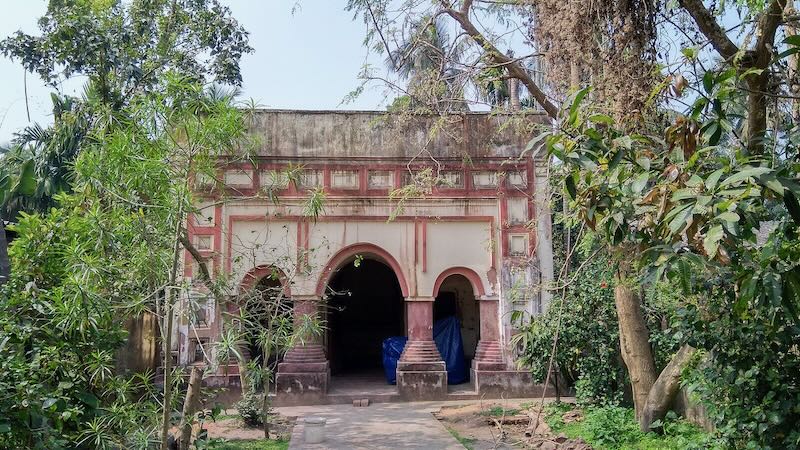Nestled near the quiet village of Bankiput, amid the rustic beauty of Bengal’s coastal countryside, the Kapalkundala Temple stands as a humble yet deeply evocative shrine dedicated to Goddess Kali. Though modest in appearance, this sacred site holds profound spiritual energy and timeless cultural value—drawing not only devout pilgrims but also literature lovers and heritage seekers.
What truly sets it apart is its enduring link to Bankim Chandra Chattopadhyay’s 1866 novel Kapalkundala, one of Bengal’s earliest literary masterpieces. The temple is more than a place of worship—it’s a living bridge between Bengal’s sacred traditions and its literary renaissance.
🕯️ A Sacred Shrine of Shakti
✔ Simple Yet Soulful – The Kapalkundala Temple may not dazzle with grandeur, but it radiates a raw spiritual energy that touches every visitor. Surrounded by coconut palms and rural silence, the temple’s unembellished walls house a powerful manifestation of Goddess Kali, worshipped with heartfelt devotion by locals.
✔ Rituals & Reverence – Worship here is especially fervent on Amavasya (new moon nights), when the Divine Mother is invoked with chants, offerings, and lamps. These nights witness a transformation of the temple grounds into a site of deep spiritual intensity, echoing ancient Tantric practices.
📖 Literary Legacy: The Bankim Chandra Connection
✔ Immortalized in Bengali Literature – The temple is intimately connected with Bankim Chandra Chattopadhyay’s iconic novel Kapalkundala. Set in this very region, the story blends spiritual mysticism, human drama, and coastal wilderness, and has inspired generations of readers and writers.
✔ A Tale Born of This Land – In the novel, the protagonist Kapalkundala, raised in isolation by a Kapalik (Tantric ascetic), meets and falls in love with Nabokumar, a nobleman. Their story of love, liberation, and moral struggle unfolds amid Bengal’s dense forests and seashores—a setting still mirrored in the landscapes around the temple.
✔ A Literary Pilgrimage – For admirers of Bengali literature, a visit to the temple offers more than spiritual grace—it’s a chance to walk the imagined path of Kapalkundala, making it a must-visit for cultural historians and literature buffs alike.
🔮 Mythology, Tantricism, and Local Lore
✔ Echoes of the Kapalik Tradition – The name Kapalkundala itself draws from Kapaliks—wandering Tantric sadhus known for their intense worship of Goddess Kali in cremation grounds and remote temples. According to local folklore, this shrine may have once been associated with ancient Kapalik rites, now faded into legend but still whispered in stories passed down through generations.
✔ A Site of Blessings and Belief – The temple is revered by locals as a place where prayers for protection, prosperity, and strength are fulfilled. Pilgrims offer flowers, lamps, and their innermost hopes, seeking the Goddess’s fierce compassion and motherly grace.
🌾 Village Life and Coastal Peace
✔ Rustic Bengal at Its Best – Surrounding the temple are sleepy villages where tradition lives on. Walk along the narrow earthen paths and discover:
- Fishermen mending their nets under the sun
- Women drawing alpana (sacred folk art) on courtyards
- Children playing barefoot under tall betel and coconut palms
The unhurried pace of life here adds to the temple’s peaceful aura.
✔ Near the Call of the Sea – Just a short walk away, the Bay of Bengal beckons with its empty beaches and soothing wave sounds, offering the perfect place for quiet reflection after your temple visit.
🌟 Why Visit the Kapalkundala Temple?
- ✔ For Devotees – Experience the divine presence of Kali Ma in a setting of pure devotion.
- ✔ For Literature Lovers – Relive the story of Kapalkundala in the land that inspired it.
- ✔ For Culture Seekers – Uncover Bengal’s hidden spiritual and literary gems, far from tourist circuits.
- ✔ For Peace Seekers – Find solace in quiet surroundings, untouched landscapes, and heartfelt traditions.
🗓️ Best Time to Visit
- ✔ October to March (Winter & Post-Monsoon) – Enjoy the cool breeze and vibrant rural scenes during this ideal travel season.
- ✔ Amavasya & Kali Puja Nights – Witness the temple’s spiritual heartbeat, alive with incense, chants, and flickering oil lamps.
💬 Final Reflections
The Kapalkundala Temple is more than a religious destination—it’s a symbol of Bengal’s soul, where the divine and the literary converge in perfect harmony.
Whether you are:
- a spiritual traveler in search of blessings,
- a fan of Bengali literature walking in Bankim Chandra’s footsteps, or
- an offbeat explorer uncovering Bengal’s quiet treasures—
this hidden temple near Bankiput offers an experience that is deep, meaningful, and unforgettable.
